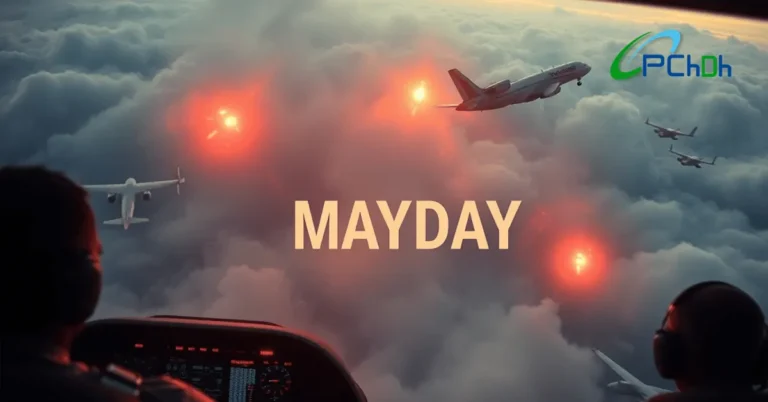Every air disaster leaves a lasting mark on aviation history. The gripping documentary series Mayday (also known as Air Crash Investigation) has brought these crucial stories to millions of viewers worldwide since 2003.
Behind each episode lies a powerful truth: understanding past aviation accidents saves future lives. These carefully investigated cases reveal critical safety gaps, leading to revolutionary changes in aircraft design, pilot training, and industry regulations.
The impact of Mayday extends far beyond entertainment. Aviation professionals use these documented cases as valuable teaching tools, while investigators reference past incidents to prevent similar accidents.
This article delves into 7 shocking Mayday episodes that transformed aviation safety:
- A devastating runway collision that revolutionized cockpit communication
- A high-tech aircraft’s mysterious Atlantic plunge
- An impossible landing with failed controls
- The world’s deadliest single-aircraft disaster
- A fuel calculation error turned triumph
- A terrifying cockpit window blowout
- A miraculous water landing in New York
These stories showcase extraordinary human resilience, technological advancement, and the relentless pursuit of safer skies. Each disaster sparked vital changes that protect millions of air travelers today.
Let’s explore how these dramatic incidents reshaped aviation safety standards and created the robust air travel system we know today.
The Mayday Series: A Window into Aviation Disasters
The Mayday documentary TV series stands as aviation’s most comprehensive storyteller since 2003. Created by Canadian production company Cineflix, each episode unravels the mysteries behind history’s most significant air disasters.
The show’s signature storytelling approach brings aviation incidents to life through:
- Detailed reenactments with professional actors
- In-depth interviews with survivors
- Testimonies from aviation experts
- State-of-the-art CGI reconstructions
- Analysis of actual cockpit voice recordings
These elements work together to create a precise timeline of events leading to each incident. The series dives deep into various aviation emergencies:
- Catastrophic mechanical failures
- Weather-related accidents
- Terrorist attacks
- Near-miss incidents
- Human error scenarios
Raw data from flight recorders, combined with official investigation reports, forms the backbone of each episode’s narrative. The show’s producers work closely with aviation authorities, manufacturers, and airlines to ensure accuracy in their reconstructions.
The series has earned recognition for its meticulous attention to technical details. Actual pilots and aviation professionals often praise the show’s authentic portrayal of cockpit procedures and emergency protocols.
Through careful analysis of cockpit voice recordings, the series reveals critical moments of decision-making under extreme pressure. These recordings provide invaluable insights into crew interactions, emergency responses, and the human factors involved in aviation incidents.
One such incident that was extensively covered in the series is the Air France Flight 447 disaster, which serves as a stark reminder of the complexities and challenges faced in aviation.
1. The Tenerife Airport Disaster – A Catastrophic Chain Reaction
On March 27, 1977, aviation experienced its darkest day when two Boeing 747s collided on a foggy runway in Tenerife. The Tenerife disaster resulted in the tragic loss of 583 lives due to a series of miscommunications.
Background
KLM Flight 4805 and Pan Am Flight 1736 were redirected to Los Rodeos Airport because of a bomb threat at their original destination. Unfortunately, thick fog reduced visibility to just a few meters, making ground operations extremely hazardous.
Sequence of Events
The deadly sequence of events unfolded through various misunderstandings:
- KLM’s captain took off without permission
- Pan Am’s aircraft stayed on the runway
- Air traffic controllers communicated in unclear English
- Radio messages overlapped, obscuring critical warnings
The runway collision sent shockwaves through the aviation community. Investigations revealed multiple instances of human error and communication failure:
“The fundamental cause of this accident was that the KLM captain took off without takeoff clearance” – Dutch Aviation Safety Board
Impact on Aviation Safety
This tragedy brought about significant changes in cockpit protocols:
- Aviation English became mandatory
- Clear terminology replaced vague expressions
- Crew resource management training was introduced
- Ground radar systems were improved
The lessons learned from this incident reshaped pilot training globally. Airlines adopted strict communication protocols, stressing the importance of clear and standardized language between pilots and air traffic controllers.
These reforms laid the groundwork for today’s aviation safety culture. The legacy of the Tenerife disaster can be seen in every pre-flight briefing and radio conversation between pilots and controllers.
2. Air France Flight 447 – The Perils of Automation Dependence
The 7 Shocking MAYDAY Stories That Changed Aviation Forever continues with Air France Flight 447’s tragic tale. On June 1, 2009, an Airbus A330 vanished over the Atlantic Ocean during a routine flight from Rio de Janeiro to Paris.
The catastrophe began when ice crystals blocked the aircraft’s pitot tubes – critical sensors that measure airspeed. This malfunction triggered a cascade of automated system failures:
- The autopilot disconnected
- Flight computers switched to alternate law mode
- Conflicting airspeed readings appeared
- Stall warnings activated intermittently
The flight crew faced a perfect storm of confusion. In darkness, at 35,000 feet, they received multiple contradictory instrument readings. The pilots’ responses revealed a startling gap between automated and manual flying skills.
The investigation uncovered a deadly combination of factors:
- Reduced exposure to manual flight operations
- Inadequate training for high-altitude stalls
- Over-reliance on automated systems
- Poor crew resource management
This disaster reshaped pilot training worldwide. Airlines now mandate regular practice of manual flying skills. Simulator sessions focus on recovering from high-altitude stalls. Crew training emphasizes the limitations of automation.
The Air France 447 tragedy stands as a stark reminder: advanced automation requires equally advanced human understanding. Modern pilots must maintain their core flying skills despite increasing technological sophistication.
3. United Airlines Flight 232 – Triumph Amidst Tragedy
The United Airlines Flight 232 disaster stands as a testament to remarkable airmanship under extreme circumstances. On July 19, 1989, a catastrophic engine failure changed the course of aviation safety forever.
The Incident
At 37,000 feet, the DC-10’s tail-mounted engine suffered an uncontained failure. Metal shrapnel from the explosion severed all three hydraulic systems, leaving the aircraft without conventional flight controls.
Captain Al Haynes faced an impossible situation:
- No ability to control aircraft pitch
- Zero rudder functionality
- Complete loss of landing flaps
- No brake system control
The Solution
The crew discovered they could achieve limited control by adjusting power to the remaining two wing engines. Through this innovative technique, they managed to guide the crippled aircraft toward Sioux City, Iowa.
Dennis Fitch, a DC-10 instructor pilot aboard as a passenger, joined the cockpit crew. His expertise helped manipulate engine thrust to maintain some directional control.
The Outcome
The emergency landing attempt resulted in a dramatic crash-landing. While 111 lives were lost, the survival of 185 passengers marked this as a “successful” crash landing given the circumstances.
The Impact
This incident revolutionized aircraft design:
- Implementation of hydraulic fuse technology
- Enhanced engine containment systems
- Improved hydraulic system separation
- Updated crew resource management training
The United Airlines 232 story transformed pilot training programs worldwide. Simulators now include total hydraulic failure scenarios, preparing crews for previously “impossible” situations.
4. Japan Airlines Flight 123 – Structural Failure Catastrophe
The haunting story of JAL Flight 123 stands as aviation’s deadliest single-aircraft disaster. On August 12, 1985, the Boeing 747SR took off from Tokyo’s Haneda Airport carrying 524 passengers and crew.
Just 12 minutes into the flight, a catastrophic structural failure changed everything. The aircraft’s rear pressure bulkhead – repaired seven years earlier – ruptured mid-flight at 24,000 feet.
The explosive decompression tore through the vertical stabilizer, destroying crucial hydraulic systems. The repair team had used a single row of rivets instead of the required double row during maintenance.
The crippled aircraft struggled for 32 minutes before crashing into Mount Takamagahara. Only 4 passengers survived, making it the deadliest single-aircraft accident in history.
Key findings from the investigation revealed:
- Improper repair techniques used during previous maintenance
- Inadequate inspection procedures
- Lack of proper documentation for critical repairs
- Insufficient quality control measures
This tragedy revolutionized aircraft maintenance protocols worldwide. Airlines implemented:
- Stricter repair documentation requirements
- Enhanced inspection procedures for structural repairs
- Mandatory double-checks on critical maintenance work
- Regular audits of maintenance facilities
The JAL 123 disaster forced the aviation industry to confront maintenance oversight weaknesses. These changes created rigorous safety standards that protect millions of passengers today.
5. The Gimli Glider – Fuel Mismanagement Crisis Averted
Air Canada Flight 143’s transformation into the legendary Gimli Glider stands as a testament to extraordinary pilot skill during fuel exhaustion.
The Boeing 767 flight from Montreal to Edmonton on July 23, 1983, faced an unprecedented crisis at 41,000 feet. A mathematical error during refueling turned critical when both engines failed mid-flight.
Captain Robert Pearson’s background as a glider pilot became the crew’s salvation. His expertise allowed him to maintain control of the powerless aircraft through precise calculations and masterful maneuvering.
First Officer Maurice Quintal spotted the decommissioned Royal Canadian Air Force base at Gimli, Manitoba. The runway’s conversion into a racing strip added complexity – drag racers scattered as the massive aircraft approached.
The 767’s nose-wheel collapsed upon touchdown, creating sparks as metal scraped concrete. All 61 passengers walked away unharmed.
Investigation Findings
Investigation revealed a critical miscalculation:
- Ground crew used pounds instead of kilograms for fuel measurement
- The aircraft needed 22,300 kg of fuel
- Only 22,300 pounds were loaded (10,100 kg)
- This left the aircraft with less than half its required fuel
Industry Reforms
This incident revolutionized aviation fuel management:
- Mandatory double-checking of fuel calculations
- Standardized fuel measurement systems
- Enhanced crew training on fuel monitoring
- Implementation of electronic fuel gauges
The Gimli Glider incident in these 7 Shocking MAYDAY Stories That Changed Aviation Forever sparked industry-wide reforms in fuel management protocols.
6. British Airways Flight 5390 – Cockpit Window Blowout Survival
British Airways Flight 5390’s near-disastrous incident is a testament to human resilience under extreme conditions.
The Incident
On June 10, 1990, the BAC-111 aircraft was departing from Birmingham Airport when an unexpected event occurred.
At an altitude of 17,300 feet, the left windscreen panel suddenly detached from the cockpit, causing immediate chaos inside the plane.
Captain Tim Lancaster found himself partially sucked out of the aircraft, with only his legs trapped in the control column. In a heroic effort, flight attendant Nigel Ogden quickly grabbed hold of Lancaster’s belt, preventing him from being completely thrown out into the devastating 500mph winds.
The Challenge
First Officer Alastair Atchison faced an unprecedented challenge:
- Managing rapid decompression at high altitude
- Flying the aircraft with restricted visibility
- Coordinating emergency landing procedures
- Supporting a crew dealing with physical exhaustion
The Investigation
After the incident, an investigation revealed shocking maintenance errors:
“84 of the 90 windscreen bolts installed were 0.026 inches too small in diameter”
It was discovered that the maintenance team had replaced the window using incorrect bolts just one night before the flight. This critical oversight prompted immediate changes in protocols:
- New protocols for windscreen maintenance
- Enhanced quality control procedures
- Revised bolt size verification systems
- Mandatory double-checking of critical components
The Outcome
Thanks to the extraordinary actions of the crew, all 87 people on board were saved. Despite suffering from severe frostbite and fractures, Captain Lancaster made a remarkable recovery and returned to flying just six months later.
This incident brought about significant improvements in aircraft maintenance standards, particularly regarding windscreen installation procedures. The legacy of BA Flight 5390 lives on through stringent safety protocols that continue to protect countless passengers today.
7. US Airways Flight 1549 – The “Miracle on the Hudson”
The US Airways Flight 1549 incident stands as a testament to exceptional pilot skill and crew resource management. On January 15, 2009, Captain Chesley “Sully” Sullenberger faced an unprecedented challenge minutes after takeoff from LaGuardia Airport.
A flock of Canada geese struck both engines at 2,818 feet, causing complete power loss. The crew had mere minutes to assess their options:
- Return to LaGuardia
- Attempt reaching Teterboro Airport
- Perform water ditching in the Hudson River
Captain Sullenberger’s split-second decision to ditch in the Hudson River saved all 155 lives aboard. The successful water landing showcased perfect execution of crew resource management protocols:
“We’re going to be in the Hudson” – Captain Sullenberger’s calm declaration before impact
First Officer Jeffrey Skiles and flight attendants Donna Dent, Doreen Welsh, and Sheila Dail executed their emergency procedures flawlessly. The coordinated evacuation allowed passengers to exit onto the aircraft’s wings and inflatable slides.
This incident revolutionized bird strike prevention strategies:
- Enhanced radar systems for bird detection
- Improved engine testing standards
- Updated wildlife management protocols at airports
- Strengthened crew training for dual engine failure scenarios
The “Miracle on the Hudson” reinforced the critical importance of pilot experience and comprehensive flight crew training. Airlines worldwide now incorporate water ditching scenarios into their emergency response simulations.
Why These Shocking Mayday Stories Matter Today
Each aviation incident documented in these 7 Shocking MAYDAY Stories That Changed Aviation Forever sparked vital improvements in modern aviation safety standards.
The Tenerife disaster revolutionized standardized cockpit communication protocols, eliminating language ambiguity during critical operations.
Air France 447’s tragedy reshaped flight crew training programs, emphasizing manual flying skills alongside automated systems management.
United Airlines 232’s innovative emergency response created new protocols for handling catastrophic system failures.
Japan Airlines 123 transformed maintenance documentation requirements, introducing rigorous inspection procedures for structural repairs.
The Gimli Glider incident established foolproof fuel calculation systems, preventing measurement conversion errors across different units.
British Airways 5390’s windshield failure led to enhanced manufacturing specifications for critical aircraft components.
US Airways 1549’s successful water landing reinforced the value of comprehensive emergency training scenarios.
These stories serve as powerful teaching tools for:
- Aircraft design improvements
- Enhanced maintenance procedures
- Strengthened pilot training requirements
- Advanced communication protocols
- Updated emergency response strategies
The aviation industry’s commitment to accident prevention builds upon these historical lessons, creating safer skies through continuous learning and adaptation.
Learn more about aviation safety advancements
These incidents continue shaping pilot training programs, aircraft design specifications, and safety regulations worldwide.
The Ongoing Journey Toward Safer Skies
Mayday stands as a powerful testament to aviation’s relentless pursuit of safety excellence. Each episode serves as a living classroom for aviation professionals and enthusiasts alike.
The series transforms tragedy into knowledge, honoring those lost by ensuring their stories drive meaningful change. These 7 Shocking MAYDAY Stories That Changed Aviation Forever represent just a fraction of aviation’s safety evolution.
Behind every safety protocol lies a hard-learned lesson from the past. Modern aviation’s remarkable safety record stems from countless investigations, innovations, and improvements.
The show’s lasting impact extends beyond entertainment – it shapes future generations of aviation professionals. Through detailed reconstructions and expert analysis, Mayday brings critical safety lessons to life.
Air travel continues to grow safer with each passing year, thanks to lessons documented in shows like Mayday. This ongoing journey toward safer skies reminds us: every aviation tragedy holds the seeds of future safety improvements.
The aviation industry’s commitment to learning from the past creates a safer future for all who take to the skies.
FAQs (Frequently Asked Questions)
What is the Mayday series and how does it contribute to aviation safety?
The Mayday series is a Canadian documentary TV show produced by Cineflix since 2003 that investigates air disasters through reenactments, expert interviews, and CGI reconstructions. It uses official reports and cockpit voice recordings to tell compelling stories of crashes, hijackings, bombings, and near-misses. By analyzing these incidents, Mayday educates viewers and aviation professionals on the causes of accidents and promotes improvements in aviation safety standards worldwide.
How did the Tenerife Airport Disaster influence cockpit communication protocols?
The Tenerife Airport Disaster involved a catastrophic runway collision between two Boeing 747s caused primarily by human error and communication failures. This tragedy highlighted the critical importance of clear and standardized communication among flight crews and air traffic control. As a result, the disaster prompted significant changes in cockpit communication protocols globally, including the adoption of standardized phraseology to prevent misunderstandings during critical operations.
What lessons were learned from Air France Flight 447 regarding automation in aviation?
Air France Flight 447 crashed over the Atlantic Ocean due to a combination of pitot tube sensor failure and pilot confusion amid automation malfunction. This incident underscored the dangers of over-reliance on automated systems without sufficient manual flying skills. Consequently, it led to advancements in pilot training focused on manual flying proficiency and better understanding of automation limitations to enhance flight safety.
How did United Airlines Flight 232 demonstrate innovation in emergency landing techniques?
United Airlines Flight 232 suffered an uncontained engine failure that resulted in the loss of all hydraulic flight controls. Despite this dire situation, the crew employed innovative emergency landing techniques using differential thrust to control the aircraft. Their skillful handling saved many lives and influenced the design of backup flight control systems, emphasizing resilience in aircraft design against catastrophic failures.
What was unique about the Gimli Glider incident and its impact on fueling procedures?
The Gimli Glider incident involved a commercial jet running out of fuel mid-flight due to errors converting between metric and imperial units during fueling. The pilots’ extraordinary gliding and emergency landing at a decommissioned airfield averted disaster. This event highlighted critical flaws in fueling procedures and cross-checks, leading to improved standards for fuel management and verification processes across the aviation industry.
Why is US Airways Flight 1549 known as the “Miracle on the Hudson” and what safety measures did it influence?
US Airways Flight 1549 earned the nickname “Miracle on the Hudson” after Captain Sullenberger successfully executed an emergency water landing following a dual engine bird strike shortly after takeoff. The incident showcased exceptional crew resource management and coordination under pressure. It led to enhanced training emphasizing teamwork during emergencies and improvements in bird strike prevention strategies to reduce similar risks in future flights.


